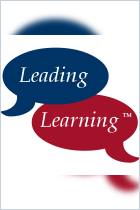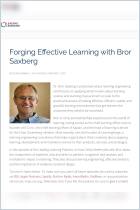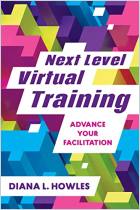Join getAbstract to access the summary!

Join getAbstract to access the summary!
Cara North
Learning Experience Design Essentials
ATD, 2023
What's inside?
Learn the basics of designing experiences that engage learners and boost on-the-job performance.
Recommendation
L&D authority Cara North outlines the key competencies of learning experience design and provides a structured process for developing effective learning experiences. Instructional design often overloads learners with content while overlooking the context and ongoing nature of learning. North challenges this status quo by emphasizing the integration of content with context built from the learners’ perspective, and by drawing on principles from user experience, user interface and accessibility. North includes guidance on creating a 30/60/90-day implementation plan to put her ideas into use.
Take-Aways
- The field of instructional design continues to evolve.
- Learning design has given way to learning experience design (LXD).
- LXD practitioners must possess research, learning needs assessment, emotional intelligence, the science of learning and facilitation skills.
- The harmonization of content, context and emotional engagement lies at the core of LXD.
- Start strong by focusing on the request’s validity and the project’s scope.
- Ensure training effectiveness by taking the learners’ perspective and linking all learning to on-the-job tasks.
- Build learning products that focus on user experience.
- Assess and evaluate your products to gauge learning gains and application.
- Communicate the why of your learning products and measure your results.
- Design learning experiences to equip individuals with the tools they need to excel at their jobs.
Summary
The field of instructional design continues to evolve.
Today, job listings for instructional design demand a multi-faceted skill set beyond just creating learning content. Instructional design traditionally involves creating storyboards and mapping curricula. Depending on where the instructional design role is located within the organization, it might focus primarily on compliance training.
“It is no longer enough to be an instructional designer. Those who can’t transition and do more, sadly, have been left behind.”
Recent trends suggest that job descriptions are expanding. Employers often expect proficiency in needs analysis, storyboarding, e-learning, learning management system (LMS) administration, and more. Additionally, instructional designers might lead training sessions – either online or in person, depending on their organization’s needs. This increasing breadth of duties raises questions about the implications for the field’s future.
Learning design has given way to learning experience design (LXD).
LXD takes an interdisciplinary approach to crafting educational experiences that emphasize the learner’s current needs and future job success. By integrating principles from psychology, human performance, learning technologies and user experience design, LXD goes beyond mere content delivery. It emphasizes the deliberate and strategic design of learning to ensure that users can effectively apply new knowledge in their work settings.
Instructional design content involves information, visuals and media that equip a person to perform a task. However, designers often overlook the human connection and how learners engage with the content. Despite advances in empathy mapping and design thinking, many instructional design models still neglect emotional engagement and focus solely on content delivery. Designers should seek three types of engagement: behavioral, cognitive and emotional. They create effective learning experiences by considering what learners do and think, but also how they feel.
“Learning experience design (LXD) is the combination of content and context to enable human performance.”
Context matters. It encompasses all the factors affecting learners as they apply what they’ve learned. Traditional e-learning, for example, can fail by not providing immediate opportunities for using knowledge or by making content refreshers difficult to access. LXD advocates for resources and practice opportunities that support performance, a concept long highlighted by learning experts.
Instructional design often focuses on imparting knowledge in a top-down manner. This approach may not suit today’s workplace, which requires personalized learning strategies that consider the work environment, learner profiles and the specific challenges employees face.
LXD practitioners must possess research, learning needs assessment, emotional intelligence, the science of learning and facilitation skills.
Acquiring basic, foundational abilities equips practitioners to develop and refine applied and strategic skills within the LXD field. It enables them to create more effective and engaging learning experiences.
Designing valuable learning experiences involves understanding the learner’s unique needs, especially in diverse environments like manufacturing, where technical proficiency can vary widely. During the COVID-19 pandemic, it was clear that not all learning requires digital solutions. After all, some employees struggle with basic computer tasks. Learning solutions can range from physical signs to software alerts, from instructor-led sessions to small group discussions, all tailored to the learner’s situation and needs.
“The key component of knowledge management is that nothing lasts forever, so we must create a system for updating and maintaining information.”
Including captions, transcripts and alternative text for images is essential to aid those who require special assistance. Also, seek clarity on who takes responsibility for delivering what and by when, and secure stakeholder support for necessary resources and organizational buy-in. Measure the effects of learning experiences using clear metrics. Seek meaningful feedback that goes beyond surface-level reactions. Always ensure that learners find the content practical and applicable.
The harmonization of content, context and emotional engagement lies at the core of LXD.
The LXD process begins with a training request, after which you must set the stage for a successful partnership with stakeholders. Gather information before meeting with stakeholders to understand the underlying issues. Next, hold a kickoff meeting to align stakeholders with the project’s success criteria, setting partnership expectations in a “scope agreement.”
Before you begin your design, walk in the learners’ shoes – learn their work and perspective on the learning needed. This builds trust and ensures that the product will meet users’ needs. Conduct a job or task analysis to identify obstacles and solutions, guiding the content curation.
“Adults want to know the why behind something. Too often, learning experiences fail because people don’t understand why they need to do something.”
Filter and curate your learning content based on whether it will aid the learner in their job and link all content to a KPI. Once you’ve developed your training product, seek feedback from the L&D team and stakeholders. To avoid an overwhelming response, set clear expectations for the type of feedback you seek. Remember to explain the training’s purpose and benefits. Post-launch, gather ongoing feedback and assess your product’s business impact. Seek meaningful evaluations that measure on-the-job learning.
Start strong by focusing on the request’s validity and the project’s scope.
As a learning experience designer, position yourself as a professional service provider and stand your ground as the expert. Build solid working relationships with your stakeholders to gain their trust. Manage expectations around project timelines and set precise requirements for taking on a project.
Ask people to answer questions that delve deeper into their needs, including the purpose of the training, the business goals sought, who else needs to get involved, and whether they have tried other ways to solve their problem or achieve their goals.
This approach prioritizes useful learning and operational alignment over mere task completion. It adds value through a structured approach to learning experience design, which is critical for the long-term development of an organization’s talent and achieving its business objectives.
“Not every problem should be solved with training. In fact, training is not a substitute for an organization with a lack of accountability.”
Include key individuals in your kickoff meeting, especially if you anticipate challenging questions. This may require inviting people with more authority than the initial stakeholder. Use the kickoff meeting to ask probing questions that unearth the root of the problem and the desired outcomes. The “action-mapping” process can help: Determine how the learning experience will enhance a business performance metric, pinpoint KPIs and decide, based on that information, whether a given piece of learning content offers the best solution. Don’t default to training as the answer to every problem.
Should you determine that training provides the best solution to the challenge, insist on a well-crafted scope agreement. It outlines roles, timelines and repercussions for missed deliverables. Draft a memorandum of understanding (MOU) to clarify responsibilities. Establish a communications plan, craft contingency plans for project deviations and maintain a log for future review. Seek stakeholder commitment and shelve projects where engagement is lacking.
Ensure training effectiveness by taking the learners’ perspective and linking all learning to on-the-job tasks.
Don’t rely on content provided by subject matter experts (SMEs) alone. Conduct a thorough task analysis to understand the actual work and challenges the people performing the tasks face. Directly observe the tasks in action and speak to workers to identify any missing elements. Leverage these efforts to refine the content and to establish clear performance criteria for the tasks at hand, ensuring focus and relevancy.
“Lean into all the work you’ve done up to this point to keep the content in the learning experience tight and targeted.”
Compare the task performance with existing knowledge management documents, such as standard operating procedures (SOPs). Gather multiple viewpoints on the task analysis and subject it to a broader review to ensure a well-rounded perspective. Next, sift through the content gathered for your course. Remove anything unnecessary for improving task performance or otherwise not aligned with the predefined metrics. This funnel approach filters content that doesn’t contribute to the learning experience objectives.
Build learning products that focus on user experience.
Build optimal learning experiences by incorporating UX (user experience) and UI (user interface) design principles. UX enhances users’ overall experience, covering how they access and where they interact with the content. UI zeroes in on the aesthetics: the learning platform’s look, feel and interactivity.
“The burden of figuring out how to access, navigate or use a learning experience should not be on the user.”
Develop a comprehensive design strategy that values functionality alongside aesthetics. Conduct user research to understand how users complete tasks and what they require for success. Continuously test and evaluate the product, making necessary enhancements to the design.
From a UI standpoint, consider interaction design, visual design and information architecture. Prioritize ease of access, visual appeal, and navigational aids like headings and anchor links. Build in feedback mechanisms to maintain up-to-date and clear content. Anchor content around task-specific needs to ensure the relevance and applicability of the learning experience.
Think of your users when it comes to accessibility as well. Accessibility in learning involves catering to learners’ diverse needs. Embrace accessible design from the outset to save time and resources. This means incorporating alternative text for visual elements, using clear headings, ensuring keyboard navigation and employing plain language to aid comprehension across cognitive abilities. Tools like the Gunning Fog Index support these efforts by checking for readability and inclusive language. Where relevant, ensure that your content works for a global audience, regardless of their technological constraints.
Assess and evaluate your products to gauge learning gains and application.
Assessment forms an integral part of learning experience design, serving as a barometer for both learners’ knowledge acquisition and the effectiveness of the learning product itself. A well-executed assessment provides invaluable insights into learners’ capabilities and identifies areas where they need additional support. It helps ensure that the learning experience aligns with KPIs, focusing on what learners need to know and can do as a result of the course. The use of scenarios as a form of assessment is particularly valuable, presenting learners with realistic situations where they can apply what they learn without real-world consequences.
“A key part of learning experience design is keeping the content targeted and precise enough to give users the information, a way to apply it to their job, and the space to practice.”
To create a high-quality product, share your learning experience with stakeholders for feedback and insights. Strategic steps that can lead to successful outcomes for both your project and your team include establishing clear criteria for quality assurance and minimizing the editing burden for stakeholders.
Communicate the why of your learning products and measure your results.
Conduct a communication campaign to explain the purpose behind your learning experience. Post-launch, actively monitor the program’s effect on participants. Attend the initial training session – observing and requesting feedback directly. Alternatively, organize a focus group for feedback.
“Too often, I see evaluations not being used in learning experiences, and when they are, they gather superficial data.”
Training evaluation often goes overlooked or only captures surface-level data. The new Kirkpatrick Model offers a framework for thorough evaluation through four levels: reaction, learning, behavior and results. Beyond evaluation, consider the environment and political factors that can affect the learning experience’s success. Keep in touch with stakeholders to gauge progress and results.
Design learning experiences to equip individuals with the tools they need to excel at their jobs.
Develop a clear understanding of the tasks involved by performing a thorough analysis and defining successful performance. Don’t rush to develop training programs based on stakeholders’ demands. Craft assessments to test users and engage them in applying what they’ve learned to their work environments.
“Stay curious and never forget the point of our work – to empower people and support them to do their jobs better.”
Take stock of your current environment, weighing both the advantages and the challenges you might face as you integrate learning experience design (LXD) into your work. Aim to broaden your perspective while focusing on users’ needs and performance outcomes.
About the Author
Cara North is a learning experience design leader with more than a decade of experience across many sectors of learning and development. She has worked in many industries, including e-commerce, higher education, manufacturing, health care and consulting.
This document is restricted to personal use only.


















Comment on this summary